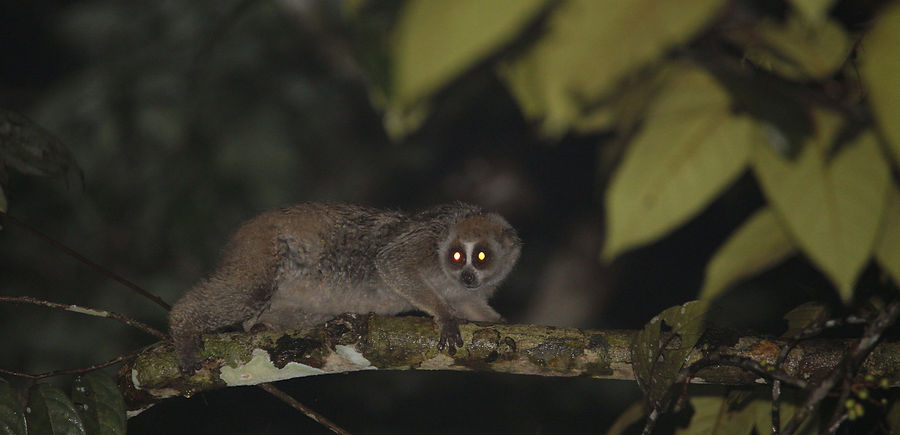Primate Watching
© Noel Thomas
Fraser's Hill, Pahang, Malaysia
Primatology
Taxonomy & Occurrence
Nycticebus coucang is a monotypic species (no subspecies). It is found in Indonesia, Malaysia, Singapore, and Thailand.
IUCN Conservation Status
Vulnerable
Slow lorises are extremely adorable. And this is one of the main reasons for their decline. They are heavily affected by pet trade.
Seeing this Species
The Greater Slow Loris is a nocturnal primate, i.e. it is active in the night. Just like a cat, slow lorises' eyes reflect a bright orange eye shine. Finding this animal requires spotlighting and very keen eyesight in the dark. When you do find a loris, please do not keep flashing the torchlight at them! Their eyes will be damaged. The slow lorises (genus Nycticebus) are also the only venomous primates. When under threat, they lick the glands on their forearms. The secretion from the glands mixed with saliva will produce a composite venom, which is then injected through bites. Even though they are generally slow-moving, slow lorises can actually act quick when catching prey such as small insects. Besides invertebrates, they also consume tree gum, fruits, leaves, and bird eggs. Visit the Little Fireface Project by Professor Anna Nekaris for more information about the lorises!
Fraser's Hill, Pahang, Malaysia
Nicknamed "The Little England of Malaysia", the colonial roots of Fraser's Hill began from the discovery of the plateau bordered by the seven hills by its namesake, Louis James Fraser. The central point of Fraser's Hill is a small clock tower, surrounded by picturesque colonial-style buildings now conserved for post office, police station, clinic, cafés, restaurants, and hotels. Just in front of the clock tower is the Puncak Inn, where you can receive free information and maps for exploring this town.
The cool climate of Fraser's Hill makes primate watching a breeze. There are 8 nature trails of varying terrain and distance. I recommend the Bishop Trail (1,500 meters) because this trail is one of the most pristine. The Pine Tree Trail (5,000 meters) is the most physically challenging with steep slopes, but features a majestic view of the mountains. Most of the other trails are wide with open canopy, probably not a good spot for primates.
Locally named as Bukit Fraser, Fraser's Hill is in the central region of Peninsular Malaysia in the state of Pahang. It is about two hours drive north of Kuala Lumpur. The second hour of drive follows an extremely winding road up to the top, at an average altitude of 1,200 meters. You may also catch a bus from the Pudu Raya bus terminal at Kuala Lumpur, heading towards Kuala Kubu Bharu.
Probability of success: ◆ ◇ ◇ ◇ ◇
Overlapping species: Long-tailed Macaque, Southern Pig-tailed Macaque, Dusky Leaf Monkey, Pale-thighed Langur, Siamang, White-handed Gibbon
Other sites:
Taman Negara National Park, Malaysia
Overlapping species: Long-tailed Macaque, Pale-thighed Langur, Siamang, White-handed Gibbon
Central Catchment Nature Reserve, Singapore
Please see the page on Raffles' Banded Langur for more information on this site.
Overlapping species: Long-tailed Macaque, Raffles' Banded Langur
Local contacts:

Fraser's Hill is home to seven species of non-human primates,
including the Pale-thighed Langur
© Andie Ang
Fraser's Hill, Malaysia

The "Little England" of Malaysia
© Andie Ang
Fraser's Hill, Malaysia
References
Page Last Updated: 7 May 2020
